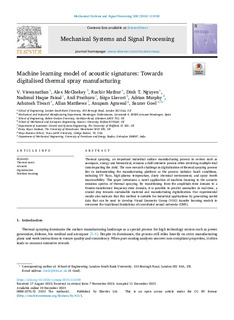| dc.rights.license | Attribution 4.0 International | |
| dc.contributor.author | McCloskey, Alex | |
| dc.contributor.author | Llavori, Inigo | |
| dc.contributor.other | Viswanathan, V. | |
| dc.contributor.other | Mathur, Ruchir | |
| dc.contributor.other | Nguyen, Dinh T. | |
| dc.contributor.other | Haque Faisal, Nadimul | |
| dc.contributor.other | Prathuru, Anil | |
| dc.contributor.other | Murphy, Adrian | |
| dc.contributor.other | Tiwari, Ashutosh | |
| dc.contributor.other | Matthews, Allan | |
| dc.contributor.other | Agrawal, Anupam | |
| dc.contributor.other | Goel, Saurav | |
| dc.date.accessioned | 2024-02-02T08:53:02Z | |
| dc.date.available | 2024-02-02T08:53:02Z | |
| dc.date.issued | 2024 | |
| dc.identifier.issn | 1096-1216 | |
| dc.identifier.other | https://katalogoa.mondragon.edu/janium-bin/janium_login_opac.pl?find&ficha_no=175901 | |
| dc.identifier.uri | https://hdl.handle.net/20.500.11984/6196 | |
| dc.description.abstract | Thermal spraying, an important industrial surface manufacturing process in sectors such as aerospace, energy and biomedical, remains a skill intensive process often involving multiple trial runs impacting the yield. The core research challenge in digitalisation of thermal spraying process lies in instrumenting the manufacturing platform as the process includes harsh conditions, including UV Rays, high-plasma temperature, dusty chemical environment, and spray booth inaccessibility. This paper introduces a novel application of machine learning to the acoustic emission spectra of thermal spraying. By transitioning from the amplitude-time domain to a Fourier-transformed frequency-time domain, it is possible to predict anomalies in real-time, a crucial step towards sustainable material and manufacturing digitalization. Our experimental results also indicate that this method is suitable for industrial applications by generating useful data that can be used to develop Visual Geometry Group (VGG) transfer learning models to overcome the traditional limitations of convoluted neural networks (CNN). | |
| dc.language.iso | eng | |
| dc.publisher | Elsevier | |
| dc.rights | © 2024 The Authors | |
| dc.rights.uri | http://creativecommons.org/licenses/by/4.0/ | |
| dc.subject | Thermal spray | |
| dc.subject | Acoustic | |
| dc.subject | Digitalisation | |
| dc.title | Machine learning model of acoustic signatures: Towards digitalised thermal spray manufacturing | |
| dc.type | http://purl.org/coar/resource_type/c_6501 | |
| dcterms.accessRights | http://purl.org/coar/access_right/c_abf2 | |
| dcterms.source | Mechanical Systems and Signal Processing | |
| local.description.peerreviewed | true | |
| local.identifier.doi | https://doi.org/10.1016/j.ymssp.2023.111030 | |
| local.contributor.otherinstitution | https://ror.org/02vwnat91 | |
| local.contributor.otherinstitution | https://ror.org/04f0qj703 | |
| local.contributor.otherinstitution | https://ror.org/026zzn846 | |
| local.contributor.otherinstitution | https://ror.org/05krs5044 | |
| local.contributor.otherinstitution | https://ror.org/027m9bs27 | |
| local.contributor.otherinstitution | https://ror.org/01f5ytq51 | |
| local.contributor.otherinstitution | https://ror.org/04q2jes40 | |
| local.source.details | Vol. 208. Artículo 111030, 2024 | |
| oaire.format.mimetype | application/pdf | |
| oaire.file | $DSPACE\assetstore | |
| oaire.resourceType | http://purl.org/coar/resource_type/c_6501 | |
| oaire.version | http://purl.org/coar/version/c_970fb48d4fbd8a85 | |








